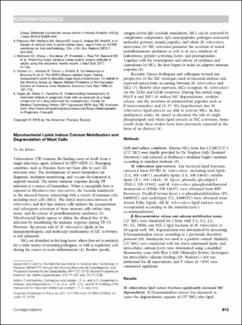Mostrar el registro sencillo del ítem
Mycobacterial Lipids Induce Calcium Mobilization and Degranulation of Mast Cells
| dc.creator | Torres-Atencio, Ivonne | |
| dc.creator | Rosero, Sara | |
| dc.creator | Ordoñez, Ciara | |
| dc.creator | Ruiz, Michelle | |
| dc.creator | Goodridge, Amador | |
| dc.date.accessioned | 2020-02-10T15:33:39Z | |
| dc.date.available | 2020-02-10T15:33:39Z | |
| dc.date.issued | 2018-09-15 | |
| dc.identifier.uri | http://repositorio-indicasat.org.pa/handle/123456789/16 | |
| dc.description | Tuberculosis (TB) remains the leading cause of death from a single infectious agent, followed by HIV/AIDS (1). Emerging countries, such as Panama, have not been able to curb TB infection rates. The development of novel biomarkers for diagnosis, treatment monitoring, and vaccine development is urgently needed. The innate immune response during TB infection is a source of biomarkers. When a susceptible host is exposed to Mycobacterium tuberculosis, the bacteria translocate to the mucosal barrier, interacting with a variety of immune cells, including mast cells (MCs). The initial interaction between M. tuberculosis and first-line defense cells induces the accumulation and subsequent activation of these immune cells within lung tissue, and the release of proinflammatory mediators (2). Mycobacterial lipids appear to define the clinical fate of the infection by modulating the immune response during TB (3). However, the precise role of M. tuberculosis lipids in the immunopathogenic and molecular mechanisms of MC activation is still unknown. MCs are abundant in the lung tissue, where they act as sentinels for a wide variety of invading pathogens, as well as regulatory cells during the course of acute inflammation (4). Besides specific antigen-driven IgE crosslink stimulation, MCs can be activated by complement components, IgG, neuropeptides, pathogen-associated molecular patterns, mainly peptides, and whole M. tuberculosis interaction (5). MC activation promotes the secretion of stored proinflammatory mediators as well as de novo synthesis of leukotrienes, platelet-activating factor, and prostaglandins. Together with the transcription and release of cytokines and chemokines by MCs, the host begins to make an adaptive immune response (6). Recently, Garcia-Rodriguez and colleagues revised our perspective of the MC strategies used in bacterial defense and reported interactions occurring between M. tuberculosis and MCs (7). Shortly after exposure, MCs recognize M. tuberculosis via the TLR2 and CD48 receptors. During this initial stage, ESAT-6 and MPT-63 induce MC degranulation, cytokine release, and the secretion of antimicrobial peptides such as β-hexosaminidase and LL-37. We hypothesized that M. tuberculosis lipid extracts are able to activate MCs. In this preliminary study, we aimed to elucidate the role of single phospholipids and whole-lipid extracts in MC activation. Some results from these studies have been previously reported in the form of an abstract (8). | en_US |
| dc.description.abstract | Tuberculosis (TB) remains the leading cause of death from a single infectious agent, followed by HIV/AIDS (1). Emerging countries, such as Panama, have not been able to curb TB infection rates. The development of novel biomarkers for diagnosis, treatment monitoring, and vaccine development is urgently needed. The innate immune response during TB infection is a source of biomarkers. When a susceptible host is exposed to Mycobacterium tuberculosis, the bacteria translocate to the mucosal barrier, interacting with a variety of immune cells, including mast cells (MCs). The initial interaction between M. tuberculosis and first-line defense cells induces the accumulation and subsequent activation of these immune cells within lung tissue, and the release of proinflammatory mediators (2). Mycobacterial lipids appear to define the clinical fate of the infection by modulating the immune response during TB (3). However, the precise role of M. tuberculosis lipids in the immunopathogenic and molecular mechanisms of MC activation is still unknown. MCs are abundant in the lung tissue, where they act as sentinels for a wide variety of invading pathogens, as well as regulatory cells during the course of acute inflammation (4). Besides specific antigen-driven IgE crosslink stimulation, MCs can be activated by complement components, IgG, neuropeptides, pathogen-associated molecular patterns, mainly peptides, and whole M. tuberculosis interaction (5). MC activation promotes the secretion of stored proinflammatory mediators as well as de novo synthesis of leukotrienes, platelet-activating factor, and prostaglandins. Together with the transcription and release of cytokines and chemokines by MCs, the host begins to make an adaptive immune response (6). Recently, Garcia-Rodriguez and colleagues revised our perspective of the MC strategies used in bacterial defense and reported interactions occurring between M. tuberculosis and MCs (7). Shortly after exposure, MCs recognize M. tuberculosis via the TLR2 and CD48 receptors. During this initial stage, ESAT-6 and MPT-63 induce MC degranulation, cytokine release, and the secretion of antimicrobial peptides such as β-hexosaminidase and LL-37. We hypothesized that M. tuberculosis lipid extracts are able to activate MCs. In this preliminary study, we aimed to elucidate the role of single phospholipids and whole-lipid extracts in MC activation. Some results from these studies have been previously reported in the form of an abstract (8). | en_US |
| dc.format | application/pdf | |
| dc.language.iso | eng | en_US |
| dc.publisher | American Journal of Respiratory and Critical Care Medicine | en_US |
| dc.rights | info:eu-repo/semantics/openAccess | |
| dc.rights | https://creativecommons.org/licenses/by-nc-nd/4.0/ | |
| dc.subject | Mycobacterial Lipids | en_US |
| dc.subject | Calcium | en_US |
| dc.subject | Mobilization | en_US |
| dc.subject | Degranulation | en_US |
| dc.subject | Mast Cells | en_US |
| dc.title | Mycobacterial Lipids Induce Calcium Mobilization and Degranulation of Mast Cells | en_US |
| dc.type | info:eu-repo/semantics/article | |
| dc.type | info:eu-repo/semantics/publishedVersion |

